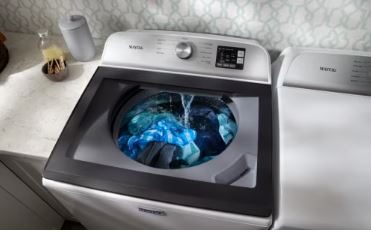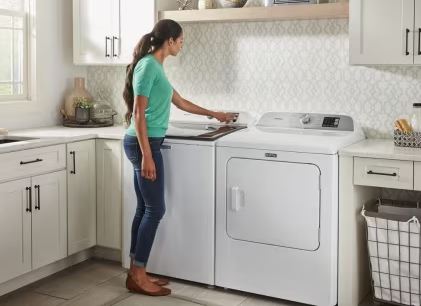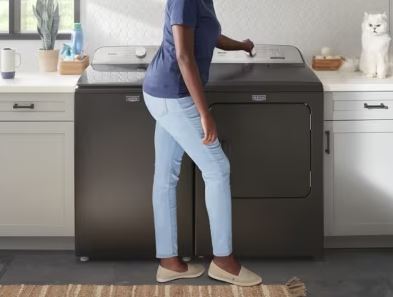Generally, your Maytag Centennial washer must spin to wash the clothes properly. But what if it doesn’t? How do you explain a Maytag Centennial washer not spinning?
A Maytag Centennial washer won’t spin due to an inadequate power supply, wrong cycle setting, an open lid, loading problems, washer imbalance, excess suds, drum obstruction, failed drainage, or component failure.
While mentioning component failure, the failed component could be the drive belt, drive motor, motor coupling, drum bearing, suspension rod, clutch, transmission, or control board. So, you should determine which component might be faulty once you reach this point.
This guide will help you identify which of those nine issues relates to your Centennial washer. Moreover, we’ll look at other related washer spin cycle problems you can troubleshoot.
Here we go!

In a rush? Below is a quick troubleshooting guide for a Maytag Centennial washer that won’t spin.
Quick Fixes for A Maytag Centennial Washer Not Spinning
| – | Possible Cause | Quick Fix |
| 1. | Inadequate Power | Check the washer’s incoming power supply. |
| 2. | Wrong Cycle Setting | Choose the correct wash cycle and setting. |
| 3. | Open Lid | Try to latch the lid firmly; if it won’t, replace the lid switch if it’s defective. |
| 4. | Loading Problem | Evenly balance the laundry and don’t overload it. |
| 5. | Washer Imbalance | Adjust loose washer feet and steady the washer on solid ground. |
| 6. | Excess Suds | Don’t put too much detergent; it should preferably be HE. |
| 7. | Drum Obstruction | Stop the washer and remove any visible obstructions from the drum. |
| 8. | Failed Drainage | Clear any clogging, unkink the drain hose, and maintain a good drain pipe height (39-96 inches) |
| 9. | Component Failure | Replace a defective or worn-out drive belt, motor, motor coupling, drum bearings, suspension rods, clutch, transmission, or control board. |
What Causes a Maytag Centennial Washer Not to Spin?
Generally, one of these reasons is why your Maytag Centennial washer stopped spinning:
1. Inadequate Power
Your washing machine requires enough power to spin. If the voltage supply isn’t enough, the washer won’t spin or wash the clothes in the long run.
Overall, the cause of the inadequate power supply could be any of these:
- A power surge – whose product is a tripped circuit breaker
- Circuit overload – just in case you don’t dedicate a circuit to the washer
- An extension cord – which doesn’t allow the washer to receive maximum power supply
Fix
First, ensure the washer hasn’t been plugged into the extension cord. If it is, plug it into the wall socket instead. Then, check the circuit breaker at the main box and flip it back on if it’s off, and if the washer doesn’t have a dedicated circuit, ask for an electrician’s help to fix it.
2. Wrong Cycle Setting
Sometimes, a washing machine won’t spin, not because something is wrong but because the cycle setting doesn’t sound right. For example, you can expect your Centennial washer not to run immediately once you select the Delayed Wash or Delayed Start function.
Also, the washer won’t spin if you select a no-spin setting, and if the clothes are bulky and you opt for a low-spin setting, you may not even realize the drum turning.
Fix
Double-check your Maytag Centennial washer cycle setting to ensure you use the correct one. Ensure the spin setting is also suitable and matches the laundry.

3. Open Lid
Maytag Centennials are among the most sensitive washers out there. These washers will stop running once they detect an open lid, which could be the case with yours.
It could be that you didn’t firmly latch the lid, or something could obstruct it. But if that’s not the case, the lid switch, which engages the lid lock to close the lid, could be faulty.
Fix
Check if there’s an obstruction around the lid and remove it. If there’s none, use a multimeter to determine if the lid switch has continuity. If it doesn’t (which proves it’s faulty), replace it.
4. Loading Problem
Ideally, you should keep the drum up to 75% full, and the clothes should be even. If they are out of balance, they will be thrown sideways and form heaps, and in the long run, the drum won’t turn.
Similarly, if the clothes are excessive, they will not turn. So, determine which of the two loading problems affects your washer and act accordingly.
Fix
Reduce the load size if the drum is more than 75% full. While at it, manually distribute the load evenly if it’s out of position.
5. Washer Imbalance
Your Maytag Centennial washer will have difficulty spinning if it’s out of balance. That may happen because the washer’s feet are loose or improperly leveled. And if that’s not the case, it could be a case of an uneven surface.
Fix
If the washer rests on an uneven surface, move it to a more uniform surface. If the feet are loose, tighten them and adjust them accordingly if they are out of level.
6. Excess Suds
The problem with excessive suds is that they interfere with the washing machine’s drainage. Once that’s the case, the washer also struggles to spin.
The excess suds could be a case of overusing the detergent (putting too much of it) or using the wrong detergent type (more so non-HE).
Fix
Avoid using too much detergent. Follow what Maytag recommends for your Centennial washer. Also, ensure you only use the detergent that the manufacturer recommends, and if you aren’t sure, use a High-Efficiency (HE) option as it suds less.

7. Drum Obstruction
You cannot expect the drum to turn if something is obstructing it. In that case, check for clothing obstructions or foreign objects such as loose screws and other metal objects.
And remember, your washer may make some grinding or screeching noise when trying to turn if there’s a metallic object obstruction.
Fix
Check for any drum obstruction and remove it. You’ll need, however, to first turn off the washer to inspect the drum.
8. Failed Drainage
Unless your washer drains appropriately, it won’t spin. So, check if that’s the case. Some of the issues that could interfere with the washer’s drainage include:
- Obstructed drain hose
- Clogged drain pump
- Clogged pump filter
- Wrong drain hose height
Fix
If the drain hose is dirt-clogged, clean it to remove the clog. And if it’s kinked, straighten it out. Also, clean the drain pump and pump filter if dirt-clogged.
Moreover, ensure the washing machine’s drain pipe height is 39-96 inches. The drain pipe should be 39-96 inches off the ground.
9. Component Failure
Lastly, if none of those eight issues relate to your Centennial washer, the washer likely doesn’t spin because of a component failure.
Here are the components to check out and possibly replace:
- Drive belt – If the drive belt is faulty, it won’t turn the drum, and the washer will, therefore, not spin. You can inspect the drive belt for wear, damage, and looseness to determine if it’s faulty.
- Drive motor – The washer will also have difficulty spinning if the drive motor is defective. That may be a case of a burnt motor, which you can visually examine.
- Motor coupling – The motor coupling links the transmission and the motor shaft, and its failure means the motor won’t turn, and if the motor doesn’t turn, the drum won’t spin.
- Drum bearings – The drum bearings support the drum as it turns. Over time, these bearings wear out; when they do, they fail to support the drum, which could be why the drum doesn’t turn.
- Suspension rods – The suspension rods absorb the excess impact or vibrations as the drum turns. However, they fail to do so when they wear out; in such a case, the drum may not spin as it should.
- Clutch – The clutch connects the transmission to the washer’s inner tub, allowing the drum to turn smoothly. Over time, the clutch wears out and fails to do its job, and the effect may be a non-spinning drum.
- Transmission – You can also expect the washer not to spin if the transmission wears out. Thus, inspect it.
- Control board – With the control board serving as the washer’s brain, the washer won’t spin if the control board fails. It’s, however, hard to diagnose, and only an expert can help you do it.
Fix
Replace any of the above components that are faulty or just worn out. If you aren’t sure, have an expert check them and replace them on your behalf.

Maytag Centennial Washer Not Spinning Clothes Dry
Sometimes, a Maytag Centennial washer won’t spin clothes dry. That means it leaves the clothes soaking wet and, at times, dirt-streaked. If that’s the case, it could be due to a power failure, wrong setting, an error code, uneven load, or laundry overload.
But if it’s none of those issues, it could be due to poor drainage – which you can tell if there’s some water sitting in the tub.
Maytag Centennial Washer Not Washing or Spinning
Consider these issues if your Maytag Centennial washer fails to spin and wash:
- An open washer lid
- Failed power supply – perhaps due to a power surge, the use of an extension, or a circuit overload
- Failed water supply – perhaps due to a disconnected or kinked supply line or inadequate water pressure
- Laundry overload – where the drum is more than 75% full
- Washer imbalance – perhaps due to loose washer feet or uneven surface
Maytag Centennial Washer Not Spinning or Draining
Rarely does a washer fail to spin and drain at the same time. It can, however, happen to a Maytag Centennial, and when it does, it’s often due to an open lid, wrong drain pipe height (something outside 39-96 inches), excess suds, drain clogging, or a faulty drain pump.
So, you’ve to go through all these checks to determine the fault, and if you can’t find any, put your Maytag Centennial washer on diagnostic mode to find a fault code that’ll tell you what might be wrong with the washer.
Concluding Thought:
Now you know the reasons for a Maytag Centennial washer not spinning. First, consider the possibility of the washer lacking sufficient power, using the wrong setting, an unlatched lid, poor laundry distribution, or an off-balance washer.
But if it’s none of those issues, it’s likely too many suds, an obstructed washer drum, bad drainage, or component malfunctioning. While speaking of component malfunction, the component could be the belt, motor, transmission, motor coupling, clutch, bearing, suspension rod, or control board.
